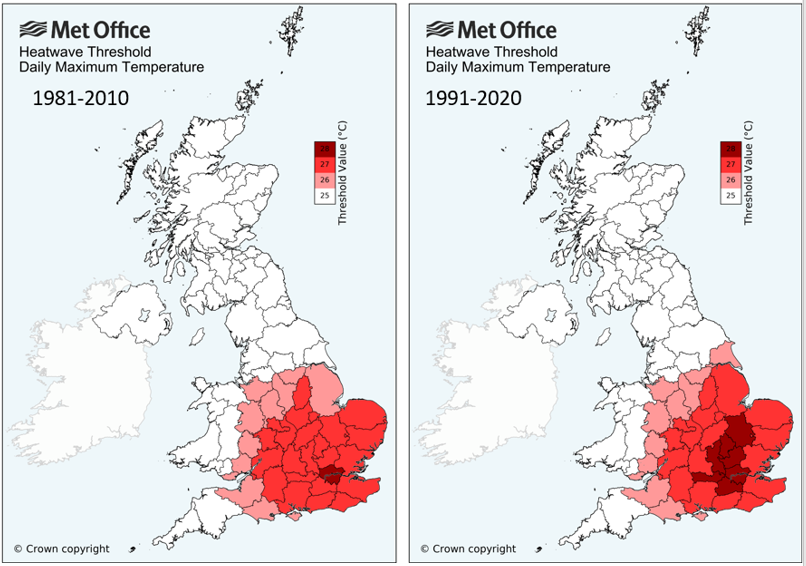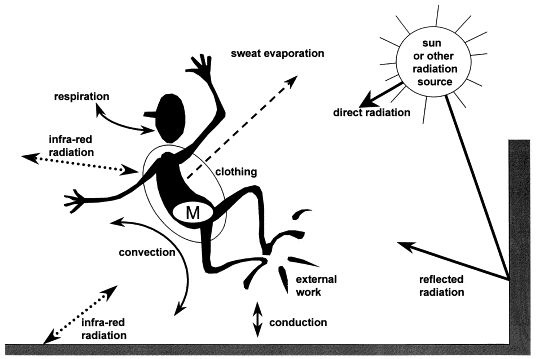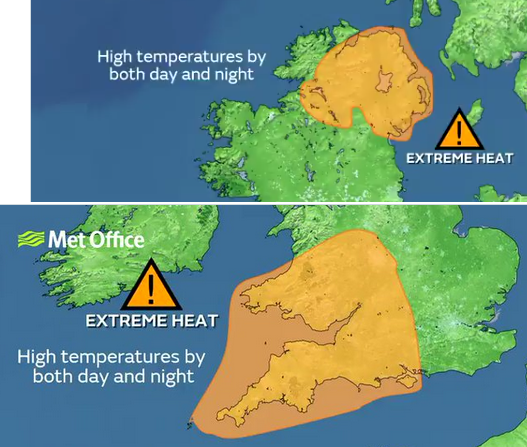
"A UK Heatwave Threshold is met when a location records a period of at least 3 consecutive days with daily maximum temperatures meeting or exceeding a Heatwave Temperature Threshold" Met Office
A heatwave is a period of extreme, unusual weather. Sustained hot weather can be dangerous and planning, advice then action is needed to get through times of extreme temperatures. A simple starting point is the temperature thresholds for counties around the UK which when met for a few days, a heatwave is declared. These thresholds were recently increased due to our warming climate.
Here in the UK, there is often initial excitement when hot and sunny weather is forecast. And with its evasive reputation, it can be greeted with great joy until the cracks appear. Cracks in the ground from drought, falling air quality, sleepless nights, health issues, infrastructure strain and an increased fire risk. There are many impacts of true heatwaves. Warnings are needed and advice with clear definitions and procedures to assist people and services as they prepare. Also, a warm and sunny spring Bank Holiday doesn’t qualify here as a heatwave, whatever the papers may claim.
“The impacts of extreme heat can be many and varied. It can have health consequences, especially for those who are particularly vulnerable, and it can impact infrastructure, including transport and energy, as well as the wider business community. During hot weather we often see increased traffic near coastal areas, increased use of open water by the public, and an increase in wildfire risk. “ MO
The WMO World Meteorological Organisation oversees and investigates temperature records with wider standards for observing and monitoring as a UN body. It has guidelines but not a strict definition for heatwaves. This allows the countries of the world to define and communicate for their own extreme weather and climatic events. Although heatwave definitions may initially relate to numeric values, other characteristics should be considered too.

A heatwave is a hotter spell of weather, compared to the seasonal average. A heatwave in India might involve temperatures well over 40C, even up to 50C but in Scotland, they would relate to temperatures greater than 25C. 25C is more likely to be passing Glasgow in summer than in Lerwick, so these calculated thresholds can still be quite clumsy. The thresholds were determined using a widely used threshold from climate research, the 90th percentile of the climatological distribution of daily maximum temperature.
The numeric values for the UK, the heatwave thresholds, have been updated recently ready for Summer 2022. This has affected eight counties, all in England. Due to our warming global climate, the baseline conditions, which are looked at each decade, now sit at a higher level for parts of the UK. So, to reach a comparative heatwave, six more areas in England are looking to the >28C band, Lincolnshire has moved to the 27C threshold and the East Riding of Yorkshire, the 26C threshold.
Met Office “Climate statistics over time reveal an undeniable warming trend for the UK. Temperature rise has been greatest across parts of central and eastern England.” National Climate Information Centre.
Previously the thresholds were calculated using 1981-2010 data but are now looking at 1991-2020 climate averaging period. This was adopted in Jan 2022 as the norm for routine UK climate monitoring products and you may see that period in the anomaly monthly maps for UK rainfall and sunshine or Copernicus Europe and World temperature.
This shift is to keep heatwaves as extreme events as we adjust to a warmer climate. If southern England is reaching 27C more often, how useful is it to continue to label it a heatwave? It is still warm, even hot and may cause issues to people and infrastructure but climatologically it isn’t hot enough compared to the ‘new normal’ climate. Climate change, with higher concentrations of CO2 in the atmosphere, leads to higher temperatures with heatwaves being more severe, and more likely. We need to adapt our lives to these changes in climate but when extreme weather events do occur, they still need to be clearly flagged.
The WMO has been campaigning about various world weather warning systems, for cyclones and flooding and now for heatwaves. Heatwave impacts are huge globally, sometimes almost by stealth rather than the dramatic visual events such as a hurricane hitting or landslides from torrential rain. The WMO works to push global public education and preparedness and the UK Met Office is often at the forefront of this expansion with its warning framework.

Human Heat budget - Havenith
Tens of thousands of people can die in heat-related events. Not just the heat stress but triggering of other underlying health issues and secondary incidents, say in open water. The ongoing high temperatures and often dry weather can lead to wildfires and poor air quality which also lead to danger or other health hazards.
The WMO guidance suggests that when a period of marked unusual hot weather is forecast, other characteristics are considered.
Magnitude – which would relate to the threshold, how much of a departure is this from the norm
Duration – how long will it go on for? A few days is often mentioned (3 days minimum here in the UK) rather than an isolated one-day peak
Extent - the geographical extent
Severity - what will be the potential damage and impacts from this heatwave event
National Met services often have a public weather service responsibility. For the UK Met Office, this includes:
Produce weather forecasts which help the UK public make informed decisions about day-to-day activities.
Warn people of extreme weather to mitigate its impacts - contributing to the protection of life, property and infrastructure.
Improve weather and climate predictions through research.
And over recent years we’ve seen flood warnings included in daily weather, pollen and UV mentioned along with the impact-based weather warnings. Still, little regular air quality information on air but the heat warnings have taken shape.
Official meteorological heatwave definition ‘A UK Heatwave Threshold is met when a location records a period of at least 3 consecutive days with daily maximum temperatures meeting or exceeding a Heatwave Temperature Threshold'. These thresholds vary around the UK. ‘
There was a forecasting need for a heatwave definition which would allow clear, authoritative communication to the public during extreme heat events. Yes or No, we have reached a Heatwave situation
This is a numeric range to highlight when values are forecast to reach a point where the temperatures would be unusual/extreme. A heatwave can’t be too elusive in terms of the threshold, nor too common. It is a statistical tool with climate flexibility and relates to summer temperatures. Although springtime can bring unseasonably high temperatures and people get excitable, there is not such a threat to health, even life.
The Met Office also works with UK Health Security Agency (UKHSA) to produce the Heat Health Service for health professionals, and this contributes to the Heatwave Plan for England. This is quite clear cut and relates to processes within the health service to help them plan. It is a specific paid for service.
In summer 2021 the UK Met Office launched its new Extreme Heat warning category and in July the first Amber Heat warning was issued. These only have Amber and Red categories and are issued in relation to weather impacts, not specific temperatures. This is the same as for rain- it’s not the amount of rainfall but what it will do on the ground, to the rivers etc
“It’s hoped the new extreme heat warning can help the public, businesses and organisations better prepare for hot conditions, thereby reducing disruption and impacts. “ MO
 Extreme heat July 2021
Extreme heat July 2021
There is a bit of a problem with communicating about hot weather to the British public. High temperatures and sunshine are seen by many as a bonus, a holy grail almost with our variable weather. Few would want a week’s summer holiday at a UK coastal resort with constant wind and rain. The media also love a fine weather story. Bournemouth hotter than Ibiza, summer scorcher, mini-heatwave, Britons sizzle in Bank Holiday sunshine… It’s a gift that keeps on giving, whether it’s true or not.

If the real weather forecasters come along with only doom and gloom, any important messages could be dismissed. There has to be a balance. Accepting that people will be glad to see fine weather, feel the heat from the sun and enjoy some real summer for a time. And yet also acknowledge that ongoing hot, dry weather will have impacts. Serious health impacts, even death. To avoid or reduce these impacts, good preparations and information are needed.
Heat warnings have to take this balance into account. Most heatwave days for urban areas occur in the high summer season of July and August, with a smaller proportion in June, smaller again in September.
Like the rain warnings take antecedent conditions into consideration, the heat warnings look at the existing and recent conditions to judge their severity, the number of days the next event will last. The extent could be localised for say, a part of SE England or widespread over Europe. Also, what will be the risks from this event?
It is not only the daytime, daily maximum temperatures, to consider. High night-time temperatures are also a health hazard. These ‘tropical nights’ (over 20C minimum) restrict a recovery period from the day’s sunny heat and keep the heat stress going. In large towns and cities, the urban heat island effect keeps night-time temperatures up, with heat being stored in the concrete fabric of the buildings. Heatwaves usually occur under high pressure situations where slowly descending air heats up day by day from the hot ground. The calm conditions give little chance for stirring and so the same warm air stays at the surface, getting hotter and hotter. Warm nights add to the severity of a heatwave affecting people a lot. Think of London by night (or day for shift workers) with people trying to sleep in unsufferable ongoing heat.
Advice is needed to help people by day and night with robust information around the forecast. People can then use this to reduce their own personal risk. The very young, elderly and those with pre-existing conditions will be more vulnerable. Also, those who work outdoors, or do physical work indoors, are isolated or homeless.

*Public Health England has been replaced by UK Health Security Agency and Office for Health Improvement and Disparities
These temperature thresholds are in the mid to high 20s Celsius, but the UK can see temperatures into the 30sC, the SE occasionally exceeding 35C. The UK record is 38.7C which occurred at Cambridge on 25th July 2019. France sometimes sees over 40C and in 2019 for the first time over 45C. Perhaps the day when the UK sees 40C is not that far away.
Meanwhile expanding climate adaptation for things such as building design and, town planning continues. More attention and focus on the mitigation of Climate Change is needed. Better and wider warning systems will attempt to save lives and reduce hospitalisations when extreme heat is forecast.
Loading recent activity...